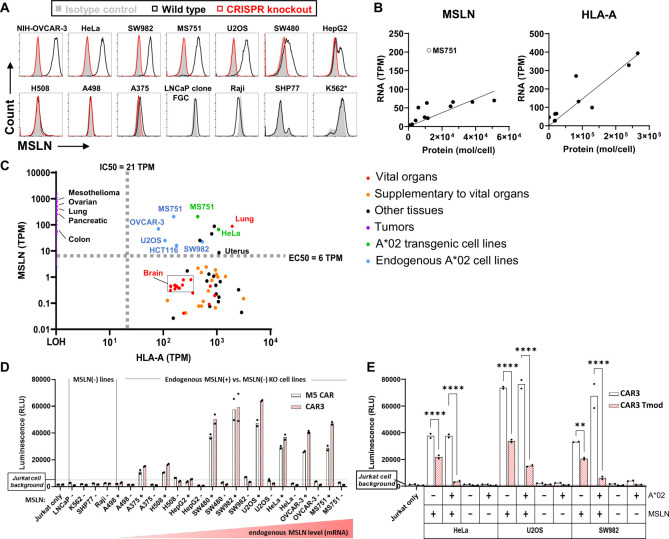Figure 2.
MSLN Tmod functions selectively with human cell lines±MSLN expression. (A) Expression of MSLN in human cell lines assessed by staining with MSLN mAb and flow cytometry. K562 displayed some cross-reactivity to the anti-MSLN antibody, although no functional reactivity to CAR3 or benchmark M5 CAR was observed. (B) Levels of MSLN and A*02 mRNA (CCLE) and protein (QIFIKIT) show correlation. Conversion between protein and mRNA levels was calculated using these standard curves (see online supplemental table 1). (C) EC50 and IC50 of construct in relation to MSLN and HLA-A expression levels in normal (GTEx database) and tumor tissues and cell lines (TCGA, CCLE databases). Conversions between protein and mRNA levels were calculated using the standard curves shown in figure 2B. HeLa and MS751 A*02 transgenic cell line variants shown on the graph (green) better mimic activator and blocker target ratios in normal tissues. Only tissues above the EC50 line express sufficient levels of MSLN to activate CAR3. Tissues above the IC50 line express sufficient levels of A*02 to engage the blocker. Therefore, all normal tissues are expected to be spared by CAR3 Tmod, including the lung. Even those vital tissues in the brain with relatively low HLA-A expression (~100 TPM) are still well above the IC50 for MSLN Tmod blocker function. In addition, MSLN expression in brain is extremely low (~1 TPM), well below the EC50 for activation. Organs were classified as vital or supplementary to vital per ICH Guidance S7A (https://www.fda.gov/media/72033/download). (D) CAR3 selectivity benchmarked against Gen2 M5 CAR on a panel of human cell lines. Activation of CARs in a Jurkat cell functional assay by MSLN(+) or MSLN(−) cell lines showed that both CARs display MSLN-specific activation. (E) MSLN CAR3 Tmod construct selectivity in a Jurkat cell functional assay on a subset of MSLN(+) and MSLN(−) control target cells showed no off-target activity. Note that the blocker slightly reduces background or tonic activation compared with CAR alone. This has been observed generally by us and by others (Hwang et al, 2021). Two-way ANOVA with a multiple comparisons test was used to calculate significance between CAR3 and CAR3 Tmod. Data shown for D–E depict the average of technical replicates. All experiments were run independently at least three times.

